Challenges for Sustainable Use of the Fish Resources from Lake Balkhash, a Fragile Lake in an Arid Ecosystem
Abstract
:1. Introduction
2. Changes in the Hydrological Regime of Lake Balkhash
3. Commercial Fishing on Lake Balkhash
4. Influence of the Hydrological Regime on the Ichthyofauna of Lake Balkhash
5. Influence of Economic and Social Factors on Fisheries in Lake Balkhash
6. Age Structure of Fish in Lake Balkhash
7. Discussion
Acknowledgments
Author Contributions
Conflicts of Interest
References
- Petr, T. Lake Balkhash, Kazakhstan. Int. J. Salt Lake Res. 1992, 1, 21–46. [Google Scholar] [CrossRef]
- Kenshimov, A.K.; Mahashova, D.; Medev, B.; Patrakov, I. The analysis of structure and activities and overview of activities in the Ile-Balkhash Basin. In Integrated Water Resources Management in the Ile-Balkhash Basin; Kenshimov, T., Ed.; Al-Farabi Kazakh National University: Almaty, Kazakhstan, 2011; pp. 144–198. (In Russian) [Google Scholar]
- Imentai, A.; Thevs, N.; Schmidt, S.; Nurtazin, S.; Salmurzauli, R. Vegetation, fauna, and biodiversity of the Ile delta and southern Lake Balkhash—A review. J. Great Lakes Res. 2015, 41, 688–696. [Google Scholar] [CrossRef]
- Sadyrbaeva, N.N. Intensity of the fishing-determining factor of estimation of state of fish stocks of Lake Balkhash. Agric. Sci. Agroindust. Complex Turn Cent. 2013, 2, 11–16. (In Russian) [Google Scholar]
- Timirkhanov, S.; Chaikin, B.; Makhambetova, Z.; Thorpe, A.; van Anrooy, R. Fisheries and Aquaculture in the Republic of Kazakhstan: A Review; Food and Agricultural Organization of the United Nations: Rome, Italy, 2010. [Google Scholar]
- Petr, T.; Mitrofanov, V.P. Fisheries in arid countries of Central Asia and in Kazakhstan under the impact of agriculture. In Papers Contributed to the Regional Symposium on Sustainable Development of Inland Fisheries under Environmental Constraints and IPFC Working Party of Experts on Inland Fisheries; Petr, T., Morris, M., Eds.; Food and Agricultural Organization of the United Nations: Rome, Italy, 1995; pp. 40–79. [Google Scholar]
- Thorpe, A.; Van Anrooy, R. Strategies for rehabilitation of the inland fisheries sector in Central Asia. Fish. Mgmt. Ecol. 2010, 17, 134–140. [Google Scholar] [CrossRef]
- Graham, N.; Pueppke, S.G.; Uderbayev, T. The current status and future of Central Asia’s fish and fisheries: Confronting a wicked Problem. Water 2017, 9, 701. [Google Scholar] [CrossRef]
- World Bank. Innovations in Fisheries Management for Kazakhstan. 2004. Available online: http://siteresources.worldbank.org/INTKAZAKHSTAN/Data%20and%20Reference/20292610/KZ%20Fish--Draft%20Report--V4-eng.pdf (accessed on 26 February 2018).
- Sorg, A.; Bolch, T.; Stoffel, M.; Solomina, O.; Beniston, M. Climate change impacts on glaciers and runoff in Tien Shan (Central Asia). Nat. Clim. Chang. 2012, 2, 725–731. [Google Scholar] [CrossRef]
- Guo, L.; Xia, Z. Temperature and precipitation long-term trends and variations in the Ili-Balkhash basin. Theor. Appl. Climatol. 2014, 115, 219–229. [Google Scholar] [CrossRef]
- Aidarov, I. Sustainable Development and Protection of Water Resources in Arid Lands. Master of Science Thesis, Ben-Gurion University of the Negev, Beersheba, Israel, 2006. [Google Scholar]
- Butorina, L.G. Lake Baikal and other Great Lakes of Asia. In The Lakes Handbook: Restoration and Rehabilitation; O’Sullivan, P.E., Reynolds, C.S., Eds.; Blackwell Publishing: Oxford, UK, 2005; pp. 179–199. [Google Scholar]
- Propastin, P. Assessment of climate and human induced disaster risk over shared water resources in the Balkhash Lake drainage basin. In Climate Change and the Sustainable Use of Water Resources; Leal Filho, W., Ed.; Springer-Verlag: Berlin, Germany, 2013; pp. 41–54. [Google Scholar]
- Kudrin, R.D.; Rubinovich, S.A. Forecast of change in the hydrologic budget, level and mineral content of Lake Balkhash in the next ten years. Hydrology 1976, 15, 54–64. [Google Scholar]
- Abdrasilov, S.A.; Tulebaeva, K.A. Dynamics of the Ili delta with consideration of fluctuations of the level of Lake Balkhash. Hydrotech. Construct. 1994, 28, 9–12. [Google Scholar] [CrossRef]
- Spivak, L.F.; Muratova, N.R.; Vitkovskaya, I.S.; Batyrbaeva, M.Z.; Alibaev, K.U.; Moldazhanov, S.G. The results of space monitoring system of reservoirs on Ile tributaries in China. In Water Resources of Central Asia and Their Use; Institute of Geography: Almaty, Kazakhstan, 2016; pp. 424–432. (In Russian) [Google Scholar]
- Terekhov, A.G.; Dolgikh, S.A. Geoinformation system of operational evaluation of the water storage in the artificial water reservoirs of the Chinese sector of the Ile River basin. In Water Resources of Central Asia and Their Use; Institute of Geography: Almaty, Kazakhstan, 2016; pp. 170–175. (In Russian) [Google Scholar]
- Dostaj, Z.D.; Giese, E.; Hagg, W. Wasserressourcen und deren Nutzung im Ili-Balchas Becken; Zentrum für Internationale Entwicklungs- und Umweltforschung der Justus-Liebig-Universität: Giessen, Germany, 2006. [Google Scholar]
- Chida, T. Science, development and modernization in the Brezhnev time. The water development in the Lake Balkhash basin. Cahiers Monde Russe 2013, 54, 239–264. [Google Scholar]
- Burlibaeva, D.M. Hydrological regime of the Ile River in the conditions of anthropogenic influence. In Water Resources of Central Asia and Their Use; Institute of Geography: Almaty, Kazakhstan, 2016; pp. 282–286. (In Russian) [Google Scholar]
- Vilesov, E.N.; Gorbunov, A.P.; Morozova, V.N.; Seversky, E.V. Degradation of the glaciation and cryogenesis of modern moraines in the northern Tien Shan. Cryosphera Zemli 2006, 10, 69–73. (In Russian) [Google Scholar]
- Xu, J.; Liu, S.; Guo, W.; Zhang, Z.; Wei, J.; Feng, T. Glacial area changes in the Ili River catchment (Northeastern Tian Shan) in Xinjiang, China, from the 1960s to 2009. Adv. Meteorol. 2015, 2015, 847257. [Google Scholar] [CrossRef]
- Lioubimtseva, E.; Cole, R. Uncertainties of climate change in arid environments of Central Asia. Rev. Fish. Sci. 2006, 14, 29–49. [Google Scholar] [CrossRef]
- Hartman, I. Kazakhstan. In Encyclopedia of Global Warming and Climate Change, 2nd ed.; Philander, S.G., Ed.; Sage Publications: Thousand Oaks, CA, USA, 2012; pp. 824–826. [Google Scholar]
- Sorg, A.; Huss, M.; Rohrer, M.; Stoffel, M. The days of plenty might soon be over in glacierized Central Asian catchments. Environ. Res. Lett. 2014, 9. [Google Scholar] [CrossRef]
- Mitrofanov, V.P. Formation of the modern fish fauna of Kazakhstan and ichthyogeographical demarcation. In Pisces of Kazakhstan; Gvozdev, E.V., Mitrofanov, V.P., Eds.; Science Publishing: Alma-Ata, USSR, 1986; Volume 1, pp. 20–40. [Google Scholar]
- Petr, T.; Mitrofanov, V.P. The impact on fish stocks of river regulation in Central Asia and Kazakhstan. Lakes Reserv. Res. Mgmt. 1998, 3, 143–164. [Google Scholar] [CrossRef]
- Serov, N.P. Eastern bream in the basin of Lake Balkhash. Works Ichthyol. Hydrobiol. 1959, 2, 80–87. (In Russian) [Google Scholar]
- Berdichevsky, L.S.; Karievich, A.F.; Lokshina, I. Results and Efficiency of Acclimatization of Fish and Invertibrates in USSR Reservoirs; Izdvo Nauka: Moscow, Russia, 1968. (In Russian) [Google Scholar]
- Tereshchenko, V.G.; Strelnikov, A.S. Analysis of rearrangements in the fish part of the Balkhash Lake community as a result of the introduction of new species of fish. Issues Ichthyol. 1995, 35, 71–77. (In Russian) [Google Scholar]
- Mitrofanov, V.P.; Dukravets, G.M. Some theoretical and practical aspects of fish acclimatization in Kazakhstan. In Pisces of Kazakhstan; Gvozdev, E.V., Mitrofanov, V.P., Eds.; Science Publishing: Almaty, Kazakhstan, 1992; Volume 5, pp. 329–371. (In Russian) [Google Scholar]
- Serov, N.P. Successes of fish acclimatization in the Balkhash basin. In Acclimatization of Animals in the USSR; Academy of Sciences of the Kazakh SSR: Alma-Ata, USSR, 1963. (In Russian) [Google Scholar]
- Burmakin, E.V.; Dombrovsky, G.V. The state of fish stocks of Lake Balkhash and the prospects for increasing catches. Izvestia 1956, 37, 5–63. (In Russian) [Google Scholar]
- Omarkhanova, Z.; Esbergenova, L.; Makisheva, Z.; Kishibekova, G. Trends in agriculture development in the Republic of Kazakhstan. Int. J. Econ. Perspect. 2016, 10, 206–212. [Google Scholar]
- Karenge, L.P.; Kolding, J. On the relationship between hydrology and fisheries in Lake Kariba, Central Africa. Fish. Res. 1995, 22, 205–226. [Google Scholar] [CrossRef]
- Van Zwieten, P.A.M.; Roest, F.C.; Machiels, M.A.M.; van Densen, W.L.T. Effects of interannual variability, seasonality and persistence on the perception of long-term trends and catch-rates of the industrial pelagic purse-seine fisheries of Northern Lake Tanganyika (Burundi). Fish. Res. 2002, 54, 329–348. [Google Scholar] [CrossRef]
- Verburg, P.; Hecky, R.E.; Kling, H. Ecological consequences of a century of warming in Lake Tanganyika. Science 2003, 301, 505–507. [Google Scholar] [CrossRef] [PubMed]
- Nurtazin, S.T.; Shimshikov, B.E.; Hoshino, B.; Salmursauli, R. Current state of the ecosystems of the lower reaches of the Ile River, causes and trends of their changes and monitoring methods. Bull. KazNU Ser. Ecol. 2013, 3, 253–259. (In Russian) [Google Scholar]
- Tilekova, Z.T.; Oshakbayev, M.T.; Yerubayeva, G.K. Assessment of norms of admissible impact on water objects of Trans-Balkhash area. Int. J. Chem. Soc. 2015, 13, 1495–1510. [Google Scholar]
- Kenzhebekov, B.K.; Assylbekova, S.Z.; Isbekov, K.B.; Anurieva, A.N. Dependence of number of individual fish species in Lake Balkhash on abiotic factors. Bull. Agrar. Tech. Univ. Fish. 2011, 2, 3–17. (In Russian) [Google Scholar]
- Tlibekov, O.K.; Vorbyova, N.B.; Popova, S.A. Dependence of catches of fish in Lake Balkhash on abiotic and biotic factors. In The Cycle of Matter and Energy in Lakes and Reservoirs, Proceedings of the Third Meeting; All-Union Hydrobiological Society Publishing House: Irkutsk, Russia, 1973; pp. 89–91. (In Russian) [Google Scholar]
- Plisak, R.P. Change in the Vegetation of the Delta of the Ili River while Regulating the Flow; Science Publishing: Alma-Ata, USSR, 1981. (In Russian) [Google Scholar]
- Schmidt, G. Reproduction and first feeding of carp. In Biology and Ecology of Carp; Pietsch, C., Hirsch, P.E., Eds.; CRC Press: Boca Raton, FL, USA, 2015; pp. 90–104. [Google Scholar]
- Mitrofanov, V.P.; Dukravets, G.M.; Melnikov, V.A.; Bambelov, A.A. Pisces of Kazakhstan, Cyprinidae (continuation); Science Publishing: Alma-Ata, USSR, 1988; Volume 3, pp. 139–140. (In Russian) [Google Scholar]
- Asylbekova, S.Z.; Isbekov, K.B.; Loparova, T.Y.; Anurieva, A.N. Influence of air emissions of the industrial complex “Balkhashtsvetmet” on the biocenoses of Lake Balkhash. Bull. Astrakhan State Tech. Univ. Ser. Fish. 2011, 1, 7–14. (In Russian) [Google Scholar]
- Shaporenko, S.I. Balkhash Lake. In Enclosed Seas and Large Lakes of Eastern Europe and Middle Asia; Mandych, A.F., Ed.; SPB Academic Publisher: Amsterdam, The Netherlands, 1995; pp. 155–197. [Google Scholar]
- Starodubtsev, V.M.; Truskavetskiy, S.R. Desertification processes in the Ili River delta under anthropogenic pressure. Water Resour. 2011, 38, 253–256. [Google Scholar] [CrossRef]
- Tairov, M.T. Fish-Farming and Fishery Reference Manual; Kainar: Alma-Ata, USSR, 1985. (In Russian) [Google Scholar]
- Salmursaula, R.; Nurtazin, S.T.; Iklasov, M.K.; Baibagysov, A.M.; Konysbaev, T.G.; Uderbaev, T.M.; Sharakhmetov, S.E.; Mukitdinov, A.M. Current state and causes of transformation of the aquatic ecosystems of the delta of the Ile River. Bull. KazNU Ser. Ecol. 2016, 4, 150–158. (In Russian) [Google Scholar]
- Karabaev, Z.; Obrevko, L. Current state of transboundary water resources in Kazakhstan. EcoNews 2005, 9, 3–5. (In Russian) [Google Scholar]
- Tilekova, Z.T.; Oshakbaev, M.T.; Khaustov, A.P. Assessing the geoecological state of ecosystems in the Balkhash region. Geogr. Nat. Res. 2016, 37, 79–86. [Google Scholar] [CrossRef]
- Kenzhebekov, B.K.; Tsoi, V.N. On the influence of the water regime on the biota of Lake Balkhash. Bull. KazNU Ser. Ecol. 2015, 3, 55–57. (In Russian) [Google Scholar]
- Kenzhebekov, B.K. Connection of some fisheries of Lake Balkhash with deviations of ecological parameters of the system. J. Sci. Analyt. Mag. 2010, 7, 92–94. (In Russian) [Google Scholar]
- Boim, L.; Morgan, G.G. The Soviet Procuring Protests: 1937–1973; A Collection of Translations; Brill: Leiden, The Netherlands, 1978; pp. 380–382. [Google Scholar]
- Government of Kazakhstan. On Approval of the Rules of Fishing. 2005. Available online: https://online.zakon.kz/Document/?doc_id=30006424#pos=1;-117 (accessed on 20 December 2017).
- Cope, T. Kazakhstan. In On the Trail of Genghis Khan; Bloomsbury: New York, NY, USA, 2013; pp. 156–169. [Google Scholar]
- Tsyba, K.P. Biology of the Eastern Bream of Lake Balkhash; Tomsk University: Tomsk, Russia, 1975; pp. 1–16. (In Russian) [Google Scholar]
- Ismukhanov, K.; Mukhamedzhanov, V. The use of irrigation systems for sustainable production of agricultural and fish products in the Republic of Kazakhstan. In FAO Fisheries in Irrigation Systems of Arid Asia; Petr, T., Ed.; Food and Agricultural Organization of the United Nations: Rome, Italy, 2003; pp. 101–114. [Google Scholar]
- Asylbekov, M.H.; Aldajumanov, K.S. History of Kazakhstan from Ancient Times to the Present Day; Atamura: Almaty, Kazakhstan, 2010; Volume 3. (In Russian) [Google Scholar]
- Chistyakov, A.A. Mechanism for Regulating the Use of Aquatic Biological Resources, Foreign Experience and Russian Practice (on the Example of the Far Eastern Region of the Russian Federation); Diplomatic Academy of the Foreign Ministry of the Russian Federation: Moscow, Russia, 2002. (In Russian) [Google Scholar]
- Voloshin, G.A. On state participation in regulation of sustainable development of the economy of industrial fisheries in conditions of economic reform in Russia. Fisheries 2010, 4, 19–21. (In Russian) [Google Scholar]
- Unger-Shayesteh, K.; Worogushyn, S.; Farinotti, D.; Gafurov, A.; Duethmann, D.; Mandychev, A.; Merz, B. What do we know about past changes in the water cycle of Central Asian headwaters? A review. Glob. Planet. Chang. 2013, 110, 4–25. [Google Scholar] [CrossRef]
- Pueppke, S.G.; Nurtazin, S.T.; Graham, N.A.; Qi, J. Central Asia’s Ili River ecosystem as a wicked problem: Unraveling complex interrelationships at the interface of water, energy, and food. Water 2018, in press. [Google Scholar]
- Abdullaev, I.; Rakhmatullaev, S. Setting up the agenda for water reforms in Central Asia: Does the nexus approach help? Environ. Earth Sci. 2016. [Google Scholar] [CrossRef]
- Abrosov, V.N. Lake Balkhash; Nauka: Leningrad, Russia, 1973. (In Russian) [Google Scholar]
- Starodubtsev, V.M. Formation of a new delta-like object in the Kapchagai Reservoir on the Ili River. Water Res. 2017, 44, 12–15. [Google Scholar] [CrossRef]
- Samakova, A.B. The Modern Ecological State of the Balkhash Lake basin; Kagnat Publishing House: Almaty, Kazakhstan, 2003. (In Russian) [Google Scholar]
- Magasheva, R.Y. Forecasting of reclamation state of modern delta of Ili River relating to regulated flow by Kapchagai Reservoir. In Genesis and Development of Saline Soils in Kazakhstan; Nauka: Alma-Ata, USSR, 1979; pp. 93–104. (In Russian) [Google Scholar]
- Bolshakova, E.V.; Pakaln, E.V. Influence of Kapchagai Reservoir on the Regime and Magnitude of River Flow; State Committee of Hydrometeorology: Alma-Ata, USSR, 1983. (In Russian) [Google Scholar]
- Skotselyas, I.I. Loss of Flow Below the Kapchagai Tract; State Committee of Hydrometeorology: Alma-Ata, USSR, 1987. (In Russian) [Google Scholar]
- Anonymous. Reports on the Activities of the Balkhash-Alakol Basin Water Management Department of the Committee on Water Resources; Ministry of Agriculture: Almaty, Kazakhstan, 1996–2006. (In Russian) [Google Scholar]
- Dostay, Z.; Alimkulov, S.; Tursunova, A.; Myrzakhmetov, A. Modern hydrological status of the estuary of Ili River. Appl. Water Sci. 2012, 2, 227–233. [Google Scholar] [CrossRef]
- Kipshakbaev, N.K.; Baygisiev, J.E.; Tursunov, A.A.; Malkovsky, I.M. System analysis of the Ili-Balkhash problem and the concept of environmental management. In The Problem of Integrated Use of Water Resources in the Ile-Balkhash Basin; KazGU: Alma-Ata, USSR, 1986; pp. 3–16. (In Russian) [Google Scholar]
- Thevs, N.; Nurtazin, S.; Beckmann, V.; Salmyrzauli, R.; Khalil, A. Water consumption of agriculture and natural ecosystems along the Ili River in China and Kazakhstan. Water 2017, 9, 207. [Google Scholar] [CrossRef]
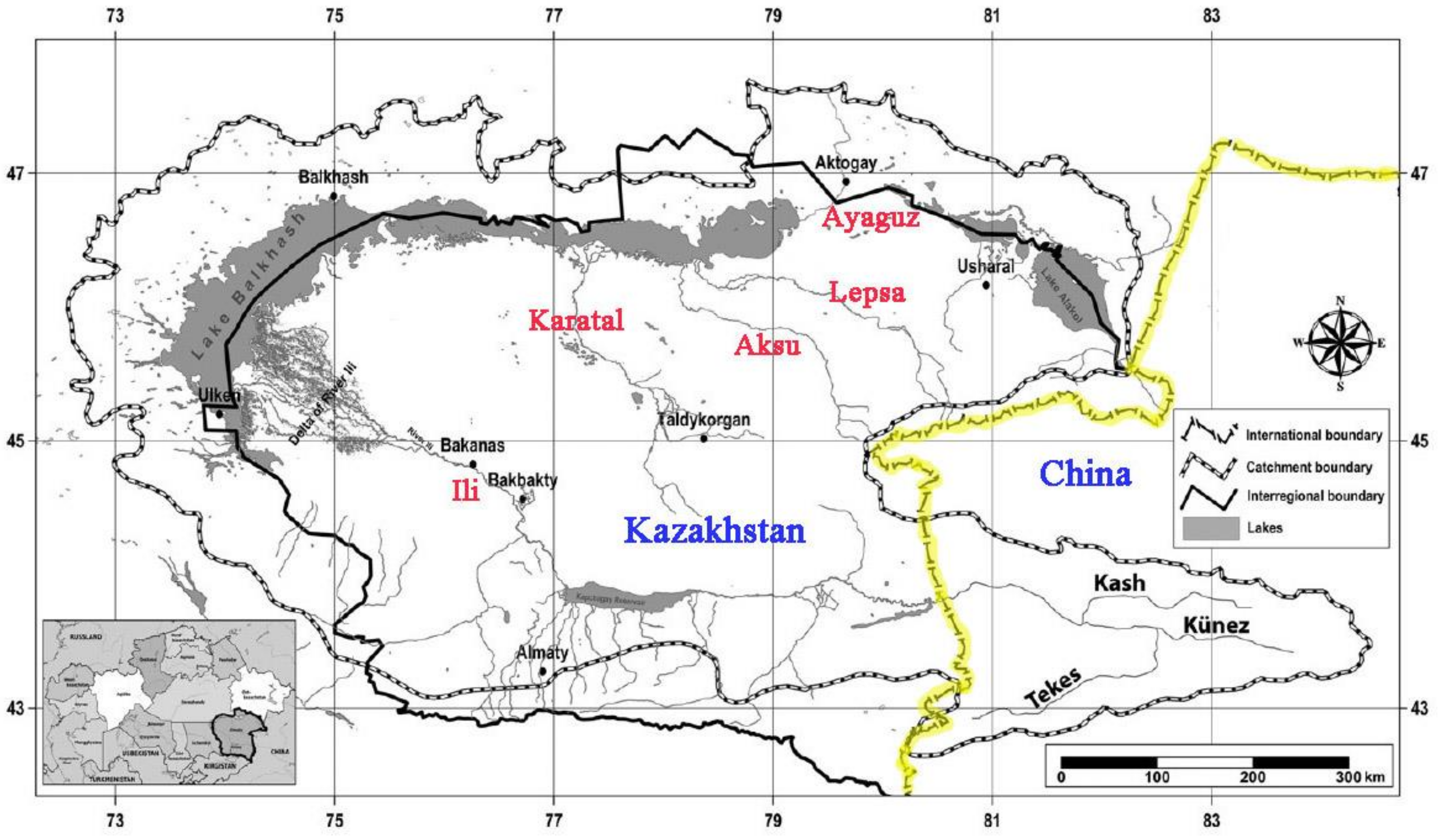

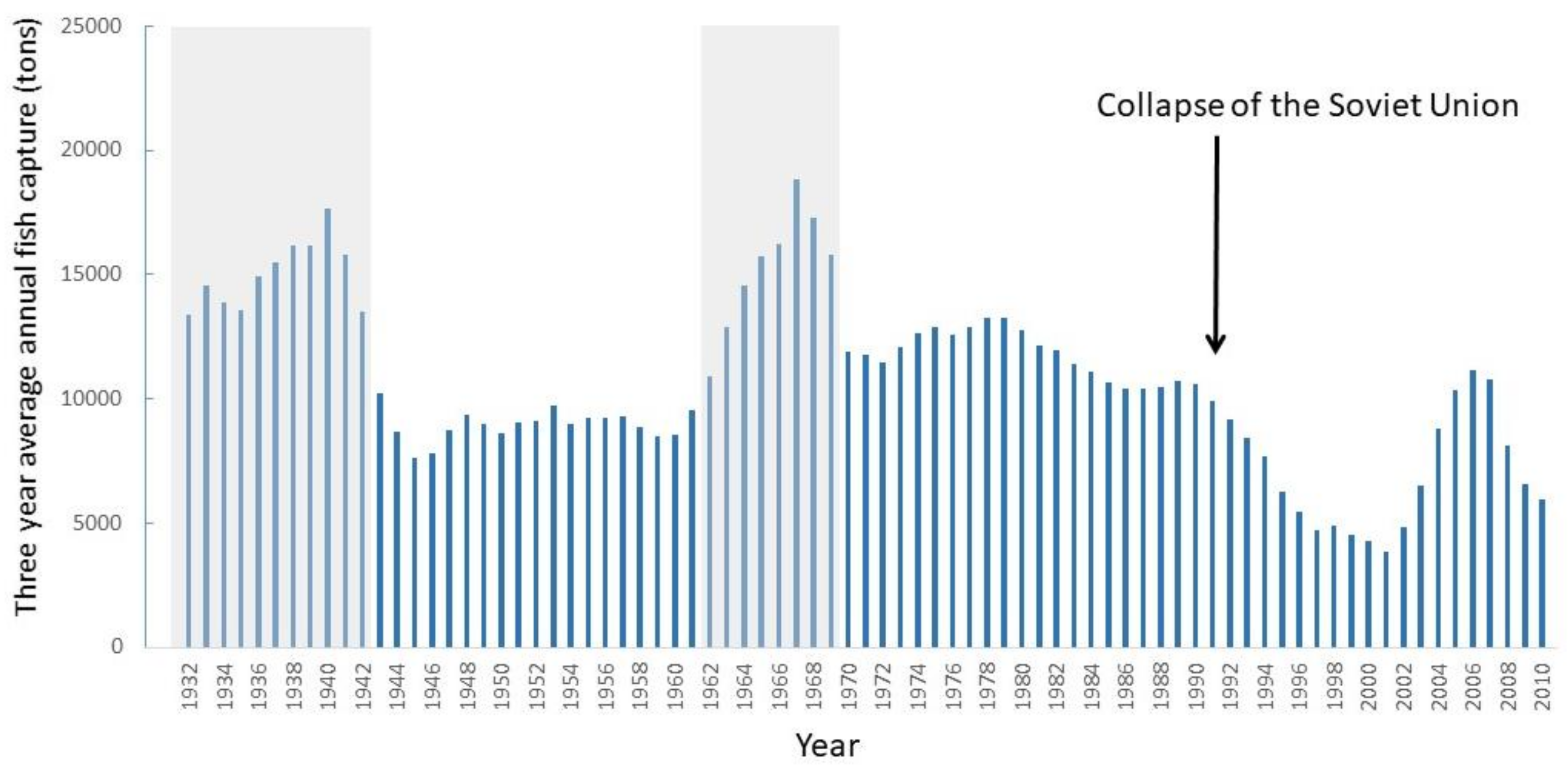
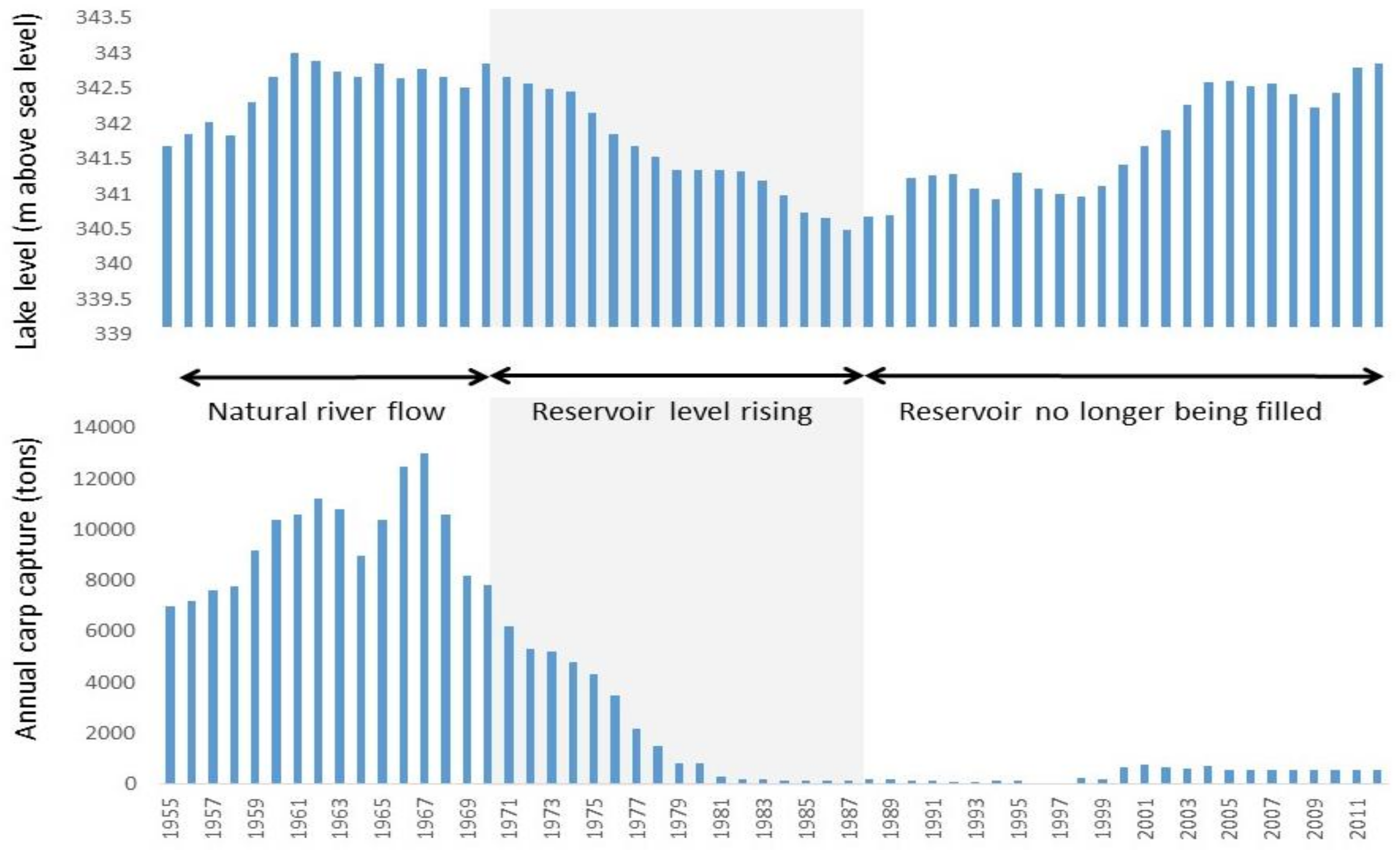
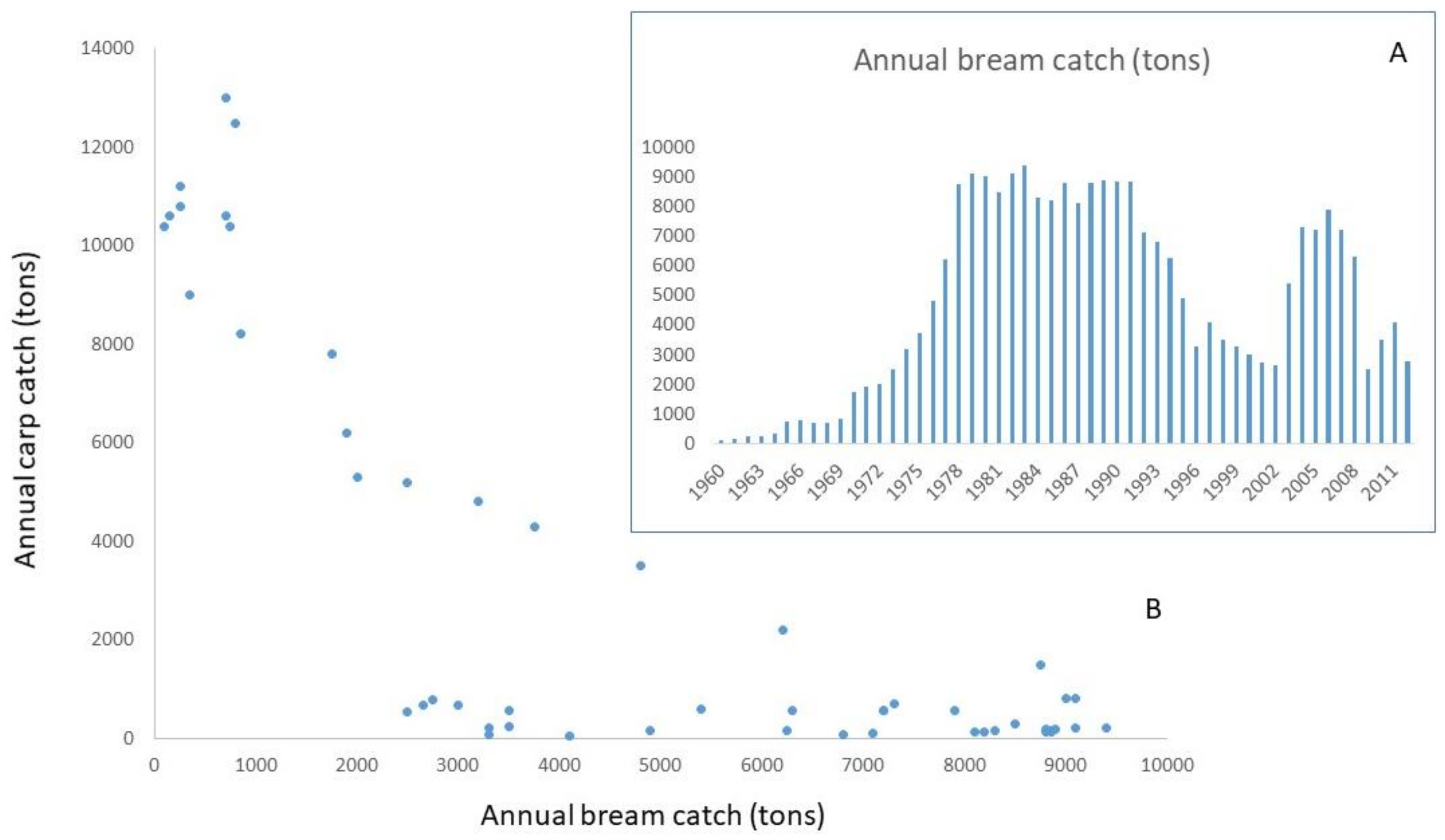
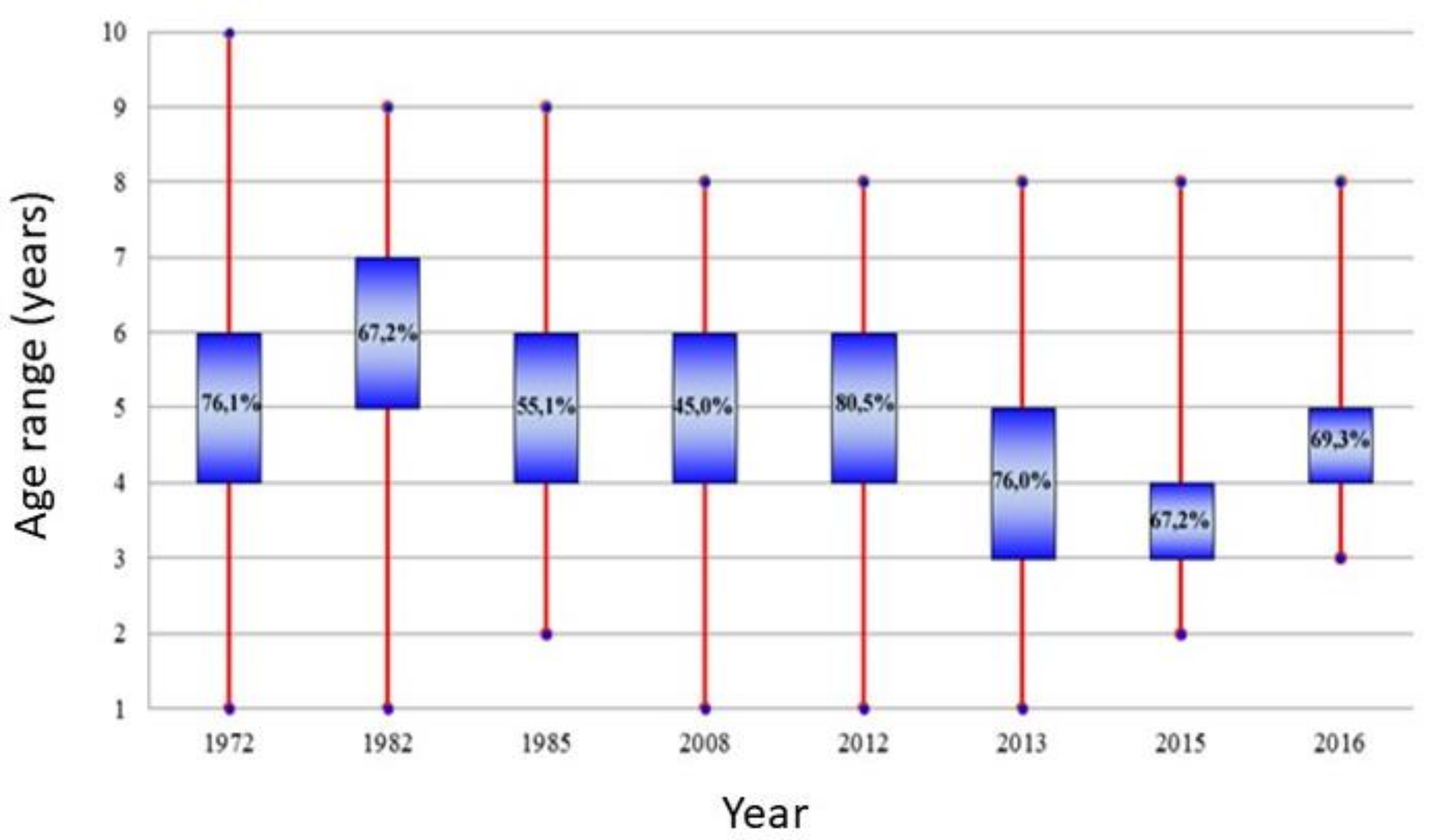
| Year | Fishermen | Total Catch (tons) | Average Catch Per Fisherman (tons) |
|---|---|---|---|
| 1960 | 664 | 8870 | 13.4 |
| 1961 | 574 | 8850 | 15.4 |
| 1962 | 641 | 11,810 | 18.4 |
| 1963 | 724 | 13,450 | 18.6 |
| 1964 | 781 | 15,040 | 19.3 |
| 1965 | 787 | 16,170 | 20.6 |
| 1966 | 775 | 16,500 | 21.3 |
| Mean | 707 | 15,115 | 18.1 |
| Sample Period | Mean Length (mm) of Fish of a Given Age | |||||
| 3 Years | 4 Years | 5 Years | 6 Years | 7 Years | 8 Years | |
| 1973–1974 | 198 | 217 | 237 | 253 | 277 | 287 |
| 1980–1984 | 153 | 187 | 216 | 245 | 260 | 280 |
| 2007 | 158 | 188 | 205 | 224 | 239 | 260 |
| 2008 | 153 | 184 | 201 | 218 | 239 | 266 |
| 2009 | 154 | 176 | 196 | 213 | 233 | 252 |
| 2015 | 152 | 195 | 218 | 224 | 241 | 272 |
| 2016 | 180 | 193 | 208 | 229 | 245 | 266 |
| Sample Period | Mean Weight (g) of Fish of a Given Age | |||||
| 3 Years | 4 Years | 5 Years | 6 Years | 7 Years | 8 Years | |
| 1973–1974 | 159 | 210 | 267 | 343 | 426 | 570 |
| 1980–1984 | 75 | 136 | 177 | 306 | 383 | 486 |
| 2007 | 79 | 135 | 179 | 231 | 288 | 347 |
| 2008 | 72 | 121 | 158 | 199 | 262 | 338 |
| 2009 | 72? | 110 | 146 | 187 | 246 | 316 |
| 2015 | 83 | 111 | 135 | 186 | 243 | 293 |
| 2016 | 132 | 136 | 171 | 241 | 293 | 374 |
© 2018 by the authors. Licensee MDPI, Basel, Switzerland. This article is an open access article distributed under the terms and conditions of the Creative Commons Attribution (CC BY) license (http://creativecommons.org/licenses/by/4.0/).
Share and Cite
Pueppke, S.G.; Iklasov, M.K.; Beckmann, V.; Nurtazin, S.T.; Thevs, N.; Sharakhmetov, S.; Hoshino, B. Challenges for Sustainable Use of the Fish Resources from Lake Balkhash, a Fragile Lake in an Arid Ecosystem. Sustainability 2018, 10, 1234. https://doi.org/10.3390/su10041234
Pueppke SG, Iklasov MK, Beckmann V, Nurtazin ST, Thevs N, Sharakhmetov S, Hoshino B. Challenges for Sustainable Use of the Fish Resources from Lake Balkhash, a Fragile Lake in an Arid Ecosystem. Sustainability. 2018; 10(4):1234. https://doi.org/10.3390/su10041234
Chicago/Turabian StylePueppke, Steven G., Margulan K. Iklasov, Volker Beckmann, Sabir T. Nurtazin, Niels Thevs, Sayat Sharakhmetov, and Buho Hoshino. 2018. "Challenges for Sustainable Use of the Fish Resources from Lake Balkhash, a Fragile Lake in an Arid Ecosystem" Sustainability 10, no. 4: 1234. https://doi.org/10.3390/su10041234
APA StylePueppke, S. G., Iklasov, M. K., Beckmann, V., Nurtazin, S. T., Thevs, N., Sharakhmetov, S., & Hoshino, B. (2018). Challenges for Sustainable Use of the Fish Resources from Lake Balkhash, a Fragile Lake in an Arid Ecosystem. Sustainability, 10(4), 1234. https://doi.org/10.3390/su10041234








